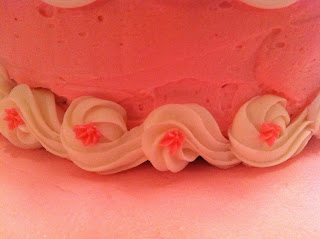It's basically a medium-sized star tip, but it's unusual because the points are cut so they angle off to one side and pipe in a bit of a spiral fashion. I love the versatility of star tips, and the 96 did not disappoint. I wanted to focus on the class and not on changing my tip constantly to decorate this cake (it's a 6" stacked on top of a 10"; plenty of real estate to pipe on), so once I put the 96 on a bag filled with Wilton Decorator Icing, I didn't change that tip again. The only other tips I used were a small, round Wilton #3 for the drop strings, and a Wilton #16 for the little hot pink stars tucked in between the shells, as you see here:
The point of the shell border, other than to look cute around the edge of the cake, is to mask the beginning and end points of all the drop strings. It's just a bunch of rather unsightly business best covered up. On the edge of another tier I used the tip #96 to pipe a row of little stars, side by side. The #16 star is just small enough to tuck a little shot of color in between each star:
It's a nice way to mix up the edges from one tier to the next. I did, however, pipe the same border on the base of each tier: a reverse shell border, with little pink stars in the centers of each whorl.
The height of this border was especially appropriate, because the goal of it was to hide the edge of the cardboard circle under the top tier. I was really interested to learn all about the infrastructure of stacked cakes, and I'll tell you all about it soon. I didn't take too many photos in class, though; I didn't want anyone to think I was trying to steal Wilton's curriculum! As if…






No comments:
Post a Comment